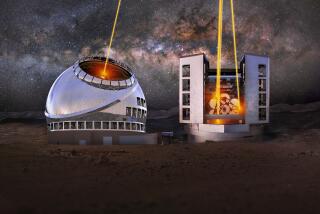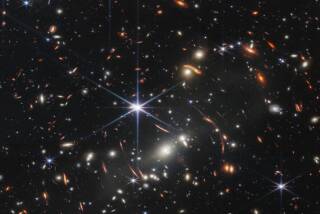Science / Medicine : Astronomy of the Future--Doing Magic With Mirrors
- Share via
TUCSON — An imaginative new technology that could have a profound impact on astronomy, making it possible for just about any university to own its own major telescope, passed a critical milestone here last week when scientists created in just 24 hours what will become the 11-foot mirror for a new telescope.
Not only does the new technology promise to greatly reduce the cost of new telescopes, it should also make it possible to build giant scopes more than twice as powerful as the 200-inch Hale Telescope on Palomar Mountain, ushering in a period of explosive growth in instruments that can see almost to the edge of the universe.
The 2-ton piece of glass was cast in a spinning furnace, a process that allows molten glass to form the concave shape of a telescope mirror as it cools. That eliminates the need to grind out tons of glass, curving the reflective surface so that it will concentrate the light it collects on a single point. Because the slow, tedious grinding process used for centuries takes months and costs millions of dollars, representatives of a wide range of scientific institutions showed up at the University of Arizona with more than casual interest to see if the new technology works.
For many of them, projects that are in the advanced stages of development hinge on its success. “The reason I’ve spent the last few years this way is I believe we can do something really special for astronomy,” an exhausted Roger Angel said last Tuesday after nursing the giant spinning furnace through a flawless and historic 24-hour marathon.
Angel, who developed the concept with the aid of a wide range of experts at the university, still has his work cut out for him, however. Over the next six weeks, the glass, called a mirror blank, must be cooled gradually for it to be strong enough to withstand the rigors demanded of a modern telescope, and then it must be ground slightly to its final shape and polished.
“There’s still a long way to go, but we’ve got what looks like a good cast,” he said as he monitored the process through two television cameras mounted on the side of the spinning furnace.
Major Milestone
It was a major milestone for the University of Arizona’s innovative team, which throughout the night had watched with a mixture of moods ranging from deep apprehension to giddiness.
The furnace began slowly spinning up to 8 r.p.m. Monday afternoon. Scientists watching television monitors could see chunks of borosilicate glass imported from Japan inside the furnace. As the day turned to night and the temperature climbed to more than 2000 degrees Fahrenheit, the chunks slowly lost their sharp edges. By early the next morning, the glass had melted into a consistency that Angel described as “like very thick honey,” and it slowly worked its way into a honeycombed mold.
Gradually, the thick fluid formed a concave surface as the centrifugal force pushed it up along the edge of the circular furnace. By mid-afternoon Tuesday, just 24 hours after the process had begun, the lid on the furnace was lifted slightly as scientists and technicians peered inside at what they had wrought, cheering wildly at what appears to have been a total success.
“It’s beautiful,” said Peter Strittmatter, director of the university’s Steward Observatory. “Just beautiful.”
The process had been tried before with smaller mirrors, but this was a test to see if the technique could be scaled up to create the giant mirrors demanded for the future. And although this procedure was officially billed as a test, the telescope that will house the mirror has already been built and stands waiting at the Apache Point Observatory in New Mexico.
That telescope, owned by the Astrophysical Research Consortium, will become the 14th largest telescope in the world. The consortium includes five universities: the University of Chicago, Princeton, New Mexico State, University of Washington and Washington State.
Don York, director of that project, has grown a long, gray beard while waiting for the mirror, and he said he had vowed not to shave it off until after the mirror is completed.
“I’m the customer,” he said, looking like a man who would really love to shave.
The ARC telescope, as it is called, will be the first “field test” of the new technology, York said, and it will be unique in other ways as well. Because the telescope has been designed to be operated remotely from any of the five participating universities, it will not even be necessary for astronomers to travel to the observatory to carry out their research.
The mirror’s surface is curved much more steeply than was practical with the old technology, and that too has major implications for astronomy. The steep curve allows the mirror to focus the light at a point much closer to its surface, thus reducing the focal length of the telescope. That means the telescope itself does not have to be nearly as large, greatly reducing the cost of the supporting apparatus.
And since the back of the mirror is a honeycombed structure rather than solid glass, it is much lighter and thus does not need a massive support system for it to track objects as they move across the field of view.
York estimated that the ARC telescope will cost only about a third of what it would have cost using prior technologies, lowering the overall cost from around $10 million to a little more than $3 million.
After this mirror is completed, the university will build another one just like it for use at Arizona’s Kitt Peak by the National Optical Astronomy Observatories, a major source of funding for the project.
If both those are successful, the furnace will be enlarged to a diameter of 29.5 feet, and an even more demanding test will begin. Angel and his team expect to produce the largest mirrors ever built, giant 8-meter chunks of glass that will be used to build some of the most powerful telescopes on the planet. The first two will be used for the Columbus Project, a binocular telescope slated for the top of Mt. Graham in Arizona, and the third will be used in the Magellan telescope that the Carnegie Institution and Johns Hopkins University plan to build at the Las Campanas Observatory in Chile.
Each of those mirrors will require only 24 hours to cast, a remarkable achievement compared to past technologies.
“The savings should be enormous,” Strittmatter said. At least 25 tons, worth about $10 a pound, would have to be ground out of an 8-meter blank and discarded under the old technique.
“It would take two years to remove it all,” Strittmatter said.
Strittmatter noted that the greatly reduced cost will bring major facilities within the reach of “any university that is serious about astronomical research.”
“You will see a lot of places with 4-meter instruments,” he added.
The success here will undoubtedly fuel a growing debate among astronomers over the design of future telescopes.
Some institutions have opted for using many smaller mirrors in place of a single large mirror, thus achieving light-weight construction. Caltech and the University of California are building the Keck Telescope on Mauna Kea in Hawaii, destined to become the largest telescope in the world. The Keck will use 36 hexagonal mirrors, each measuring 6 feet in diameter, but each of those mirrors must be controlled perfectly by computers if they are to act as one reflector.
Pushed Into New Areas
That introduces what Angel calls a “gee whiz” element because technology must be pushed into new arenas if the Keck is to succeed. Some scientists believe that road is fraught with pitfalls that could prove very costly in the years ahead because a complex support system must continue to operate flawlessly throughout the lifetime of the instrument.
A single giant mirror can function just as well, Angel said, “without any gee whiz at all,” as evidenced by Palomar, which has dominated astronomy for half a century.
George Preston, former director of Carnegie’s Mt. Wilson Observatory in Pasadena, said the cost of running and maintaining a multiple mirror telescope--which he called “active support”--could be crippling.
“Active support for the mirror prices a lot of people out of the game,” he said. “If somebody gave us a telescope like that, Carnegie couldn’t afford to run it.”
Angel’s work has been funded by the National Science Foundation at about $1 million a year for the past four years. The spin furnace cost about $900,000, which he expects to be offset entirely by savings on the first 8-meter mirror.






